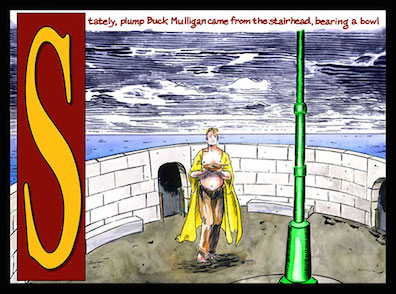Later in the chapter, Mulligan will thrust the mirror in
Stephen's face: "Look at yourself, he said, you
dreadful bard!" Stephen sees a poorly dressed,
lice-infested body and thinks of a Robert Burns poem about the
humbling effect of beholding oneself objectively, as others
do. Mulligan has his own unflattering literary analogue for
Stephen staring into the glass; he thinks of Oscar Wilde's sentences
about the ugly and bestial Caliban seeing his face in a
mirror. Stephen steps back from the mirror, and from these
bitter self-reflections, to make the glass emblematic of the
literary art that he hopes to practice: "It is a symbol of
Irish art. The cracked lookingglass of a servant." For Joyce,
fiction had the duty
to represent human reality accurately, and that meant
depicting Irish society with all its paralyzing flaws. The
first person to whom Ulysses holds up a mirror is
Oliver St. John Gogarty, a.k.a. Mulligan.
The razor too accretes associations as the chapter goes on.
Mulligan repeatedly calls Stephen “Kinch”
and explains the significance of his nickname: "O, my
name for you is the best: Kinch, the knife-blade."
But knives are not associated only with the perverse jesuit
who "killed his mother" and has "something sinister" in him.
They also adhere to the man who shaves his face on top of the
tower, and who "lunges" toward each of his companions in the
room below "a thick slice of bread, impaled on his
knife." Mulligan is a medical student, and has seen
corpses "cut up into tripes in the dissectingroom."
As Antinous and Claudius in the Homeric and Shakespearean
analogues underlying the tower
ménage, he carries concealed weapons, looking for
opportunities to do harm.
All of these associations resonate as Mulligan hooks "his
arm in Stephen's and walk[s] with him round the tower, his
razor and mirror clacking in the pocket where he had thrust
them," and as Stephen contemplates the exchange
about mirrors that precedes the seemingly friendly linking of
arms: "Parried again. He fears the lancet of my art as
I fear that of his. The cold steelpen.” The two men
are locked in an embrace that is anything but genial. In
symbols like mirrors and razors, and in actual physiological
phenomena like flushed
cheeks, their bodies tell the story of rising hatred.

